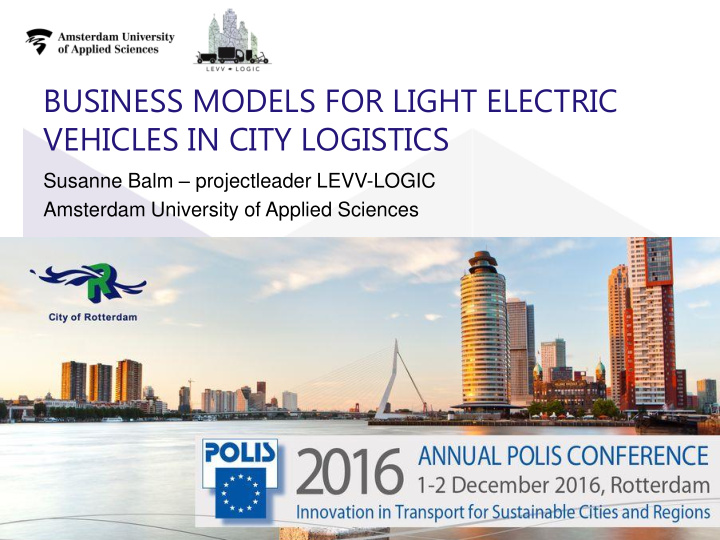



BUSINESS MODELS FOR LIGHT ELECTRIC VEHICLES IN CITY LOGISTICS Susanne Balm – projectleader LEVV-LOGIC Amsterdam University of Applied Sciences 1
BUSINESS MODELS FOR LIGHT ELECTRIC FREIGHT VEHICLES IN CITY LOGISTICS Susanne Balm – projectleader LEVV-LOGIC Amsterdam University of Applied Sciences How to create, deliver and sell the value that these vehicles bring for city logistics? 2
3
BURNING PLATFORM • 10-15% urban traffic is freight, in some neighborhoods even up to 50% • 80% is light commercial van today • Urban freight becoming more fine mazed and time critical • CO2, air quality, noise, damage • Livability and vitality of cities are at danger • Uptake of electric commercial vehicles going slowly (only 0,16% in NL) 4
CITY LOGISTICS SECTOR HAS TO DEAL WITH CHALENGES THAT ARISE FROM: Demanding customers Policy makers • Smaller shipment size • Reducing congestion • 24/7, fast, on time • Sustainable cities • Informed • Walkable cities 5
LEFV’s could be the solution for many (type of) deliveries Waste collection Food delivery DHL – Parcel and courier Painting services Bubble Post – Refrigerated ANWB - Car repair On the go drinks - Stint Urban Arrow – Albert Heijn - food Groceries Deudekom – Facilities Stint – Heijmans - Ikea - Furniture Construction Goupil – PostNL – Parcel and post 6 6
FIRST RESEARCH RESULTS ON THE USE OF LEFV’S SHOW GROWTH AND DIVERSITY EU survey (n=84) What year did you start providing cycle logistics solutions? NL cases (N=68) Many different sectors for which LEFV are used: Food delivery being nr 1. 7
We focus on: - Horeca and food - Construction and services - Parcel B2B and B2C RESEARCH RESULTS ON - Waste collection FREIGHT CHARACTERISTICS Approx 50% from < 30km distance 8
GREAT POTENTIAL FOR LEFV , BUT … STILL IN INNOVATION PHASE • LEFV’s are produced and used on small scale • Vehicle suppliers are not yet sure about best vehicle design and technology • Senders of goods not sure whether same service level can be guaranteed with LEFV • Lack of understanding on characteristics of potential freight flows • Logistics service producers need to adjust their logistics processes to use LEFV cost-effectively • Smart ICT needed for efficient planning • Policy makers not sure about supportive regulation and infrastructure • Cultural change needed among drivers • No guts , no glory 9
DISCUSSING THE BUSINESS MODEL The implementation of light electric freight vehicles is not about replacing a vehicle. It is about rethinking logistics business models. HOW TO CREATE, DELIVER AND SELL VALUE WITH LEFV? What are key challenges and opportunities according to you? E.g: : • Logistics concept • ICT • HRM • Cooperation within the sector • Governmental policies • Maintenance services • Infrastructure • Vehicle technology • Awareness among customers 10 (Business model canvas, Osterwalder)
The implementation of light electric freight vehicles is not about replacing a vehicle. It is about rethinking logistics business models. Need to adjust • Logistic logistic processes • Senders and service Long-, short term or receivers of Delivery that is: providers random/ad hoc. freight and • Providers of • Fast services logistics • Quite within, to and facilities from cities • Clean • Vehicle • Focus on • suppliers Healthy large volumes • Policy • with small Occupies makers shipment size little space • Vehicle technology • ICT systems • Online • Infrastructure • Flexible personnel Increases when acceptance LEFV is cheaper than a Personnel costs can be lower, of polluting vehicels gets (electric) van as driver license is not required lower 11
RETHINK THE LOGISTICS CONCEPT How to (re)organize the logistics chain with LEFV? A few examples Other facilities DB Schenker Other modalities DHL Other customers Deudekom 12
Approx 30 participants already! LEVV-LOGIC: 2 year research project on the use of light electric freight vehicles for city logistics RAAK-mkb | 2016-2018 Contact: levvlogic@hva.nl Susanne Balm (s.h.balm@hva.nl) 13
Recommend
More recommend